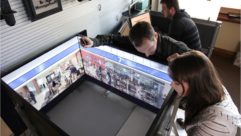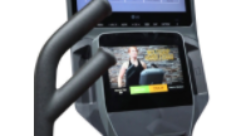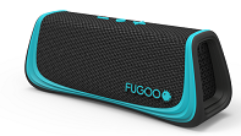
Exercising Technology
Nov 1, 2004 12:00 PM,
By Rosanne Soifer
Installing Audiovisual Systems in Gyms and Fitness Rooms.
Grunt. Sweat. Stretch. Kvetch. Most contemporary fitness venues are light-years away from the no-frills gyms that trained the Rocky Balboas of the recent past. Gone, for the most part, are the testosterone-permeated rooms where the amenities (stretching the definition somewhat) consisted of an AM radio and a soda machine.
Ceiling-mounted televisions on the fifth floor of the flagship Crunch Fitness Center, Chicago, are part of an integrated AV system.
Sound & Video Contractor surveyed the burgeoning field of health and fitness clubs, including a luxury spa run by a management company in a 5-star hotel, a corporate fitness center, and chain health clubs. Sound and video consultants were contacted, as was PlayNetwork, one of the largest providers of creative entertainment solutions for businesses. Sound & Video Contractor also looked at the initial setup, current growing pains, and management of an exercise room in a co-op apartment building, the existence of which was responsible for turning the writer into a gym rat at mid-life.
TRENDS
“The current trend in this field is headed towards ‘multi’ everything — fitness equipment, technology, and distinct workout areas in those facilities with the space to do so,” says Michael Vendetti, systems engineer with Video Corporation of American (VCA), an audiovisual broadcast and professional digital video systems integrator and reseller of videoconferencing and visual communication systems. “You must be prepared, especially when dealing with large facilities, to offer multi-zoned systems for the spa area, yoga area, cardio theater, the lounge, etc. VCA generally acts as a consultant on these projects. However, sometimes consultants do not necessarily sell products or services, but are in the position to recommend both.”
“We now offer training sessions online for our members who need specific help and may not be able to come in on a regular basis,” says Cheryl Ogreen, manager of the Plus One Spa at New York City’s Waldorf-Astoria Hotel. “Internet-based client service is a fast growing area for us.”
Personalized technology is the hallmark of another Plus One location: the corporate fitness center at Merrill Lynch in New York City. “With individual flat screens on each piece of cardiovascular equipment, the end user can choose exactly what they want,” says Plus One senior VP Tom Maraday. “More and more equipment manufacturers are now getting involved; audio is now an important component of their product.”
“In a growing chain like Equinox, many administrative decisions are now centralized, rather than made on a club-by-club basis,” says Christina Scott, general manager of Equinox Fitness on East 54th Street in New York.

According to Ryan Risenmay, director of marketing and communications for PlayNetwork, the flagship Crunch Fitness Center in Chicago wanted an integrated AV system that would showcase the Crunch environment, which was divided into 11 distinct zones with distinctly different needs:
Music Programming: Provide entertainment for all general areas. The music content is stored on a PC with dedicated hard drive.
Video Programming: Provide video entertainment via Dish Network.

Speakers and paging system at Crunch Fitness Center, Chicago.
Group Exercise Schedule Programming: Facilitate programming and display of group exercise schedule.
CCTV/Security System: Provide display of cameras at multiple locations throughout the club for recording and realtime monitoring.
FM Modulation: Broadcast audio from video content throughout the club.
Televisions: Position televisions strategically throughout the environment.
LCD Screen: Provide a display system to show aerobics class schedules. Origination of schedule is from the character generator PC.
Music Zones: Distribute programming to all parts of the club except the childcare center, drying rooms, and group exercise rooms.
Paging Zones: Provide a paging system as appropriate throughout the club using the existing phone system.
Group Exercise Rooms: Provide an independent system for each group exercise room that is intended for aerobic instruction.
Boxing Ring: Enable the room’s audio source to switch from the main music programming to a local microphone.
FLEXING CORPORATE MUSCLE
Many staffed fitness centers in the corporate world are run by management companies, a relatively new type of business entity that’s very common in real estate. Basically, a management company functions as the middleman between the end user (the fitness center customers who are corporate employees or building residents) and the host venue (the corporation or residential dwelling). Members of the fitness center staff, if there is one, are employees of the management company; not the host.
“Corporate fitness centers have experienced significant growth over the past three years, for the simple reason that big companies recognize that healthy employees increase productivity and cut health care costs,” says Plus One’s Maraday. “That alone can justify the cost of an onsite fitness center, and many companies strongly encourage their employees to use it.”
Plus One provides budgeting, equipment procurement, and internal marketing and branding services to gyms at large luxury hotels such as New York’s Waldorf-Astoria. Plus One’s proprietary Global Access Platform (GAP) offers clients a membership management system. Yet, unstaffed fitness centers and exercise rooms are found in relatively low-cost motels that cater primarily to business travelers, such as Comfort Inn, TraveLodge, and Holiday Inn.
“Generally, hotel management is realizing that business travel can be stressful and business travelers want to re-create some of the comforts of home while they’re away,” says Ogreen.
In addition, people want to work out close to home. “The media has determined that at least 80 percent of Americans are health and fitness obsessed,” says Russ Dubrow, president of Electronic Technology in Palos Verdes, Calif. “Thinking logically, apartment managers saw that it was in their best interests to keep tenants on the premises for services such as fitness centers.”
According to Scott at Equinox Fitness, rather than plunking down interchangeable fast food-type venues in various locations, Equinox wants to create what’s called a “third space” — a space that’s not work and not home. A venue that provides a service, and where someone can unwind and socialize.
“A goal of each location is to integrate into the neighborhood as a building, regarding color schemes and architectural style,” says Scott.
Demographers and sociologists, in their studies of exurbia and suburban sprawl, have lamented the loss of third spaces — Laundromats, coffee shops, beauty parlors, barber shops, and even churches and synagogues — that used to be within walking distance of any given neighborhood. These places are now located mostly at strip malls, which are only accessible by car.

Seward Park inhouse fitness center.
“Apartment managers — whether working for co-ops, rentals, or condos — started realizing about 15 years ago that they could — and should — compete with the Ys and the chain health clubs,” says Stoney Welsh, the onsite manager at Seward Park Co-op apartments in New York, managed by Cooper Square Real Estate. “Often, this meant renovating previously unused or misused space.”
The Seward Park exercise room presents a typical case study in changing demographics. Located on New York City’s Lower East Side, Seward Park voted to go fair market several years ago in order to revitalize a potentially extraordinary and stable neighborhood. The new residents asked for amenities like a decent supermarket, an upscale kosher deli, a renovated park, an indoor parking garage, a neighborhood coffee shop, and an exercise room.
For the fitness room, the board of directors designated a previously underused room. Most of the work involved soundproofing and adding lighting and mirrors. Two TVs were mounted to the walls. Unfortunately, the TVs were often tuned to two different stations at top volume, which elicited complaints, as did the constant radio music coming from speakers that had controls in a separate, locked room. Often, all three audio sources were in use at the same time. Now, however, the central audio sources are being replaced with a transmitter device for personal use, which can be accessed through a Walkman.
The primary issue, however, was entrance security. A bio-ID by the door that read members’ fingerprints malfunctioned and had to be recoded frequently. Relying on building keys for access allowed tenants who were not members of the exercise room to enter unchecked. To finally solve the problem, Securecom is installing a PassPoint Access Control System. The system works like a garage door remote. Individual key fobs disengage the electronic lock and buzzes in each member. The exercise room operates 24/7.
INTEGRATIVE TECHNOLOGY
Mounted TV screens and background radio music are quickly becoming passé. Health club/fitness center projects are often multi-faceted, encompassing a basic gym, weight room, café, spa, and retail shop. Each area requires different technology. The most basic service is music. A facility should not pipe the same highly caffeinated music used for aerobics classes into a spa area specializing in thermal foot massage and seaweed wraps.
“We generally recommend subscription services,” says Vendetti of VCA.
Equinox managers chose genre-appropriate music, and DMX prepared a disc of two-hour times segments. Equinox receives a new disc each month.
Club Com provides fully integrated content for screens and music for Plus One’s center at Merrill Lynch. Play-Network’s installation for Crunch defined a primary music zone in the facility, with volume controls accessible by managers.
A large, staffed facility obviously has more complex requirements, such as internal communications, than a small unstaffed one. Instructors of large classes may need a wireless body mic, such as the Sennheiser HS1, which withstands humidity and excessive movement. State-of-the-art spin rooms, says Vendetti, often try to create an atmosphere with background music and a curved screen showing changing scenery, often with co-ordinated lighting and surround sound.
But by far the biggest change, according to Maraday of Plus One, is fitness equipment manufacturers such as Cybex, Lifefitness, and Technogym, that are integrating audio and flat-screen technology on individual bikes, treadmills, cross trainers, and other components of the cardiovascular theater. The user of an exercise bike can now put on headphones to check his heart rate, watch a favorite program, or access music stations: a set-up similar to that used by airline passengers.
PUMPING TECHNOLOGICAL IRON
Where and how can an independent sound and video professional look to enter this market? For starters, you might want to plan strategies for three distinct target areas:
- New construction in which architectural plans include a health/fitness center,
- Existing structures, such as older office buildings and apartments that are undergoing renovation, and
- Gym facilities that are looking to upgrade.

Specialized areas at Crunch Fitness Center, Chicago, include (above) fitness machines and (below) an adult-size slide.
“Get in before the project starts,” says Dubrow of Electronic Technology about new construction. “Get to know the people involved from the beginning. But before you start touting all the bells and whistles, know what the builder expects the end result of the room to be.”
“Check the billboards outside the construction site and go from there,” says Michael Vendetti of VCA. “If it’s a commercial office building you should also try to hook up with the real estate manager. With a gym franchise such as Gold’s and World, it couldn’t hurt to get to know the individual franchisees that may be able to direct you to a vendor to work with.”

“Keep in contact with the developers and architects,” says Welsh of Seward Park. “Start going to industry trade shows for real estate managers, developers, and the construction industry.”
“A management company like Plus One works with the architects that are chosen by the host venue for the renovation work,” says Ogreen of The Waldorf-Astoria about getting work on existing structures.
“It’s important to remember that the host [or the host’s rep] controls the space in question and that any final decisions are made by them,” says Plus One’s Marady.
“Keep an eye out for any renovation projects and construction crews and an ear open for neighborhood gossip,” advises Welsh. “It may be good to get in touch with the real estate manager or landlord if it’s a rental. And in a co-op, any proposal has to go through the board.”
For getting work on a gym upgrade, sometimes a personal contact (or gym membership) is all it takes. “On a tour of a gym I wished to join, the manager started showing me where they planned to upgrade the sound system and the TVs. I gave him my card, and I was on my way,” says Dubrow. “Gym and fitness center managers have no idea what they want regarding technology when they upgrade — they’re fixated on the fitness equipment and the atmosphere.”
Knowing people like moonlighting fitness trainers and body builders (who often have a following at several gyms and whose recommendations carry a lot of weight, so to speak), interior designers, and corporate communications staff can facilitate a meeting with those with check-signing power.
DO YOUR HOMEWORK
Who has hiring clout on the project? The earlier you get involved, particularly with the architect or the construction manager, the better your chances are of landing a client. Don’t wait until the place is about ready to open before making an appearance.
Fitness facilities in chain or franchise hotels are generally contracted through a central office, with most of the work going through one company.
You cannot sell or install background subscription services such as DMX, PlayNetwork, or Muzak unless you are an authorized AV contractor. Contact contractors directly for further information.
Learn something about fitness equipment, especially the manufacturers that are now using integrative technology. You may be able to create a job involving tech support and installation.
Explore whether the potential client sees the facility as a gym, exercise room, fitness center, health spa, or a multi-faceted facility, who the end users are, and how membership fees will be determined. This information may impact your potential budget calculations.
As with almost any job, make sure you understand a client’s procedures regarding billing, requisitions and p.o. numbers, liability and insurance. Make sure they understand the importance of service contracts.
Look the part. You don’t have to be built like Arnold Schwarzenegger, but if it looks like the most exercise you get is reaching for the remote with one hand and a bag of Doritos with the other, you won’t be taken too seriously. Or better still, join a gym that’s beginning to upgrade. Your income could expand while your waistline contracts.
Thanks to Scott Kersey of Merrill Lynch.
Rosanne Soiferis a professional musician, freelance writer, and mid-life gym rat living in NYC. She can be contacted at[email protected].










